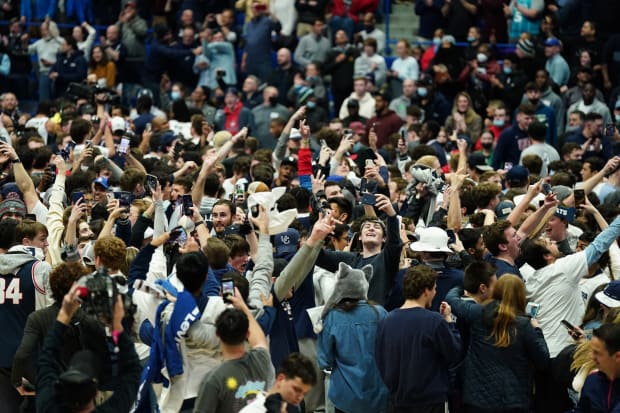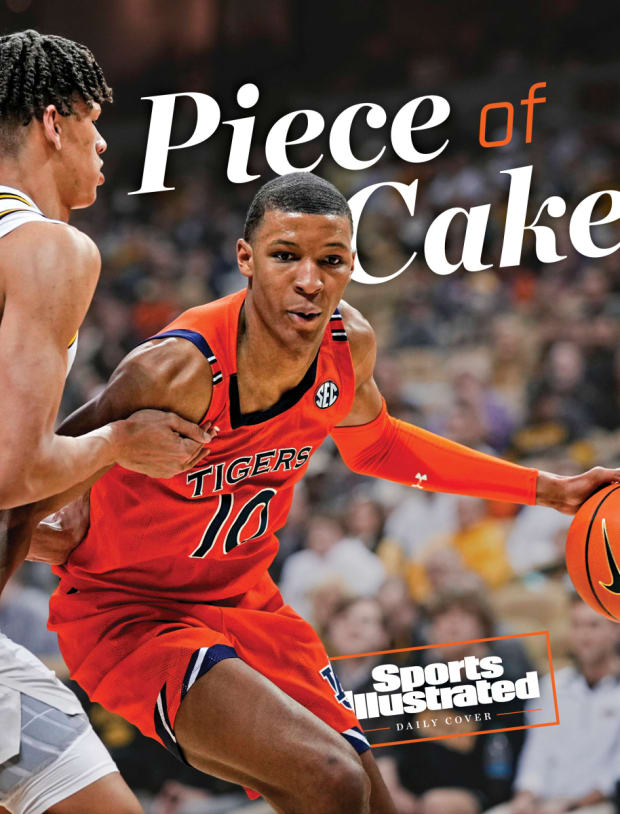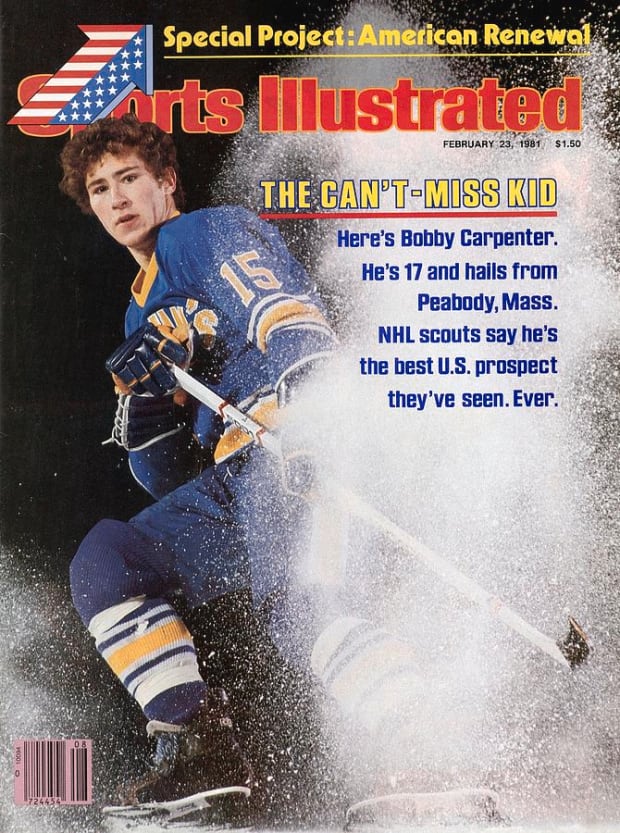A classic clash in the Big East.
Good morning, I’m Dan Gartland. I promise I’ll do my best to put aside my home-state bias here.
If you're reading this on SI.com, you can sign up to get this free newsletter in your inbox each weekday at SI.com/newsletters.
The madness started early

David Butler II/USA TODAY Sports
As we count down the final days of February and prepare for March Madness, keep an eye on the Big East.
The 11-team conference currently has three teams ranked in the men’s AP Top 25. (Only the Big 12, Big Ten and SEC have more ranked teams.) No. 11 Providence (22–3) is in first place with a 12–2 conference record. The other two teams—No. 8 Villanova and No. 21 Connecticut—met last night in Hartford in what ended up being a classic game.
It had all the ingredients for a great college hoops game: an electric crowd, a baffling officiating decision, a whole bunch of lead changes and, finally, a court-storming.
The crowd: UConn fans sold out the XL Center in anticipation of the clash with the Wildcats. Students who made the 26-mile trip from Storrs were booing Villanova players an hour before the game started. The official attendance was recorded as 15,564. And they were loud. Perhaps the best way to get a sense of the noise the fans made is to watch this video of Villanova’s Caleb Daniels shutting them up by making a contested three.
The bad call: Late in the first half, UConn coach Dan Hurley got ejected for picking up two quick technical fouls. The first was for slamming the scorer’s table after the Huskies’ Tyrese Martin failed to draw a foul call on a drive to the basket. The second was the ridiculous one. Immediately after the first tech, Hurley turned to the crowd and pumped his arms to encourage them to make some noise. The gesture earned him another tech and sent him to the locker room.
The back-and-forth game: The lead changed 18 times, including six in the final eight minutes, and the game was tied nine times. Villanova led by four points with 21 seconds to play and wound up losing the game. First UConn’s Tyler Pollet came off a screen to hit a three with 20.9 seconds on the clock and cut the Wildcats’ lead to 69–68. Then, R.J. Cole stole the ball from Villanova’s Collin Gillepsie and, after a timeout, drove to the rim for the go-ahead basket. After the final buzzer, UConn fans stormed the court.
What’s next: It was UConn’s first win over Villanova since the 2014 NCAA tournament and one of its most impressive victories of the season. (The Huskies also beat Auburn, currently ranked No. 3, in double overtime in the Bahamas in November.) In his latest Bracket Watch, published before last night’s game, SI’s Kevin Sweeney had UConn as a No. 5 seed, Villanova as a No. 3 seed and Providence as a No. 4 seed. The tournament is famously unpredictable, but it wouldn’t be a shock to see any of those teams, having been sharpened by a tough conference slate, make a deep run.
Check tomorrow’s newsletter for more on the men’s and women’s college hoops landscapes heading into March.
The best of Sports Illustrated

Jay Biggerstaff/USA TODAY Sports
Jabari Smith has No. 3 Auburn poised for a national title run, having played well enough this season to be the likely top pick in this summer’s NBA draft, according to SI’s Jeremy Woo. Woo uncovers Smith’s long-held love for baking and also breaks down what makes the 6'10" freshman’s game so sweet:
“Nothing about Jabari Smith Jr. is particularly flashy—his highlight reels consist primarily of difficult shots, which don’t always look that challenging, mostly because he’s the person taking them. There’s a balletic style to Smith’s scoring progressions, the way he shoots off midair pirouettes and relies on jab steps and toe taps while sizing up defenders. He is not a flashy dribbler, nor does he need to be. If he takes a shot you’ve never seen him try before, rest assured it’s been drilled behind the scenes.”
Tom Verducci thinks baseball’s biggest problem isn’t being discussed during bargaining talks this week between the league and the union. … The latest episode of SI Weekly features Katie Nolan discussing her return to TV for the Olympics with NBC and more. … Kevin Hanson ranks the top 100 prospects for this year’s NFL draft. … Conor Orr says attempting to decipher Aaron Rodgers’s Instagram posts isn’t worth the effort.
Around the Sports World
Here’s an explainer about the 12-day cleanse Aaron Rodgers says he just completed, which sounds frankly nightmarish. … USMNT star Weston McKennie broke his foot in Juventus’s Champions League game. … Phil Mickelson was dropped by longtime sponsor KPMG after his controversial comments about the Saudi-backed breakaway tour.
SIQ
The sideline scuffle involving Michigan and Wisconsin over the weekend brought to mind other instances of men’s college hoops coaches losing their cool. The most famous example of a coach’s emotions boiling over occurred on this day in 1985, when Indiana’s Bob Knight threw a chair across the floor at Assembly Hall. But the chair wasn’t Knight’s first choice of projectile. What did he later say he had initially wanted to throw?
- A clipboard
- His jacket
- His shoe
- His belt
Check tomorrow's newsletter for the answer.
Yesterday’s SIQ: Who scored two goals for the U.S. in the Miracle on Ice game?
Answer: Mark Johnson. He scored at the end of the first period to tie the game 2–2 and again at 8:39 into the third period to tie it at three. One minute and 21 seconds later, Mike Eruzione found the back of the net with what proved to be the game-winning goal.
Johnson’s father, Bob, a Hall of Fame inductee, coached the U.S. to a fifth-place finish at the 1976 Winter Olympics. The younger Johnson played at Wisconsin before a long NHL career with the Penguins, North Stars, Whalers, Blues and Devils. He’s been the head coach of the women’s hockey team at his alma mater since 2002, leading the Badgers to six national championships. He also coached the women’s national team to a silver medal at the ’10 Olympics.
From the Vault: Feb. 23, 1981

Manny Millan/Sports Illustrated
The profile of the high school phenom is a somewhat common SI cover trope. Guys like LeBron James, Bryce Harper and Sebastian Telfair have all been introduced to a worldwide audience by landing on the front of the magazine. Before them, it was Bobby Carpenter, the 17-year-old hockey player from Peabody, Mass., who was touted as the best American NHL prospect ever.
E.M. Swift’s cover story lays out Carpenter’s impressive résumé—his dominance at training camp with the U.S. junior national team, the way he toys with opponents in the Massachusetts Catholic Conference, glowing praise from scouts and college coaches. It also places Carpenter’s draft stock in context. At the time, Americans simply didn’t become NHL stars. (Before Carpenter’s rookie year, only two Americans had recorded 30-goal seasons in the NHL.)
There had been exactly two Americans selected in the first round of the NHL draft to that point: Mike Ramsey, who went 11th overall to the Sabres in 1979, and Rik Wilson, who was picked 12th by the Blues in ’80. (The draft began in ’68.) And no high schooler had ever been selected in the top 60. The draft was dominated by Canadians who played high-level junior hockey, like Hall of Famer Dale Hawerchuk, who went No. 1 in Carpenter’s class.
Carpenter ended up being selected third, one of three non-Canadians taken in the 21-pick first round, and became the first player to ever make the jump from high school directly to the NHL. He recorded 32 goals and 35 assists as an 18-year-old rookie, finishing eighth in Calder Trophy voting. (Hawerchuk won the award after tallying 103 points.)
Carpenter might not have become the U.S-born star that Swift said “the sport of hockey so desperately needs,” but he did have a strong 18-year NHL career and even scored 53 goals in the 1984–85 season.
Check out more of SI's archives and historic images at vault.si.com.